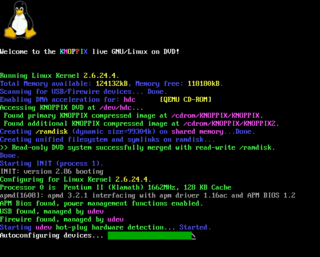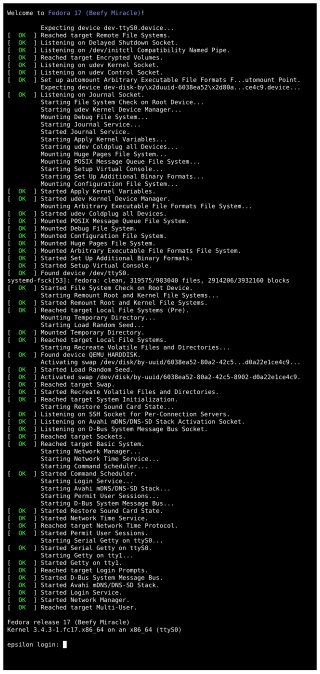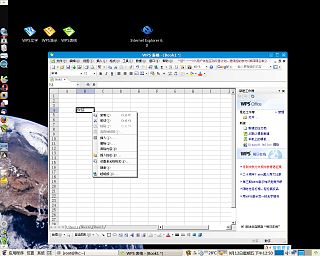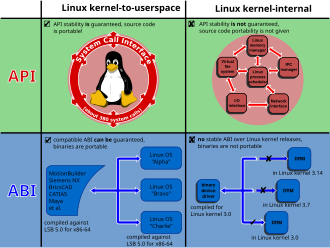
An operating system (OS) is system software that manages computer hardware and software resources, and provides common services for computer programs.
The Portable Operating System Interface is a family of standards specified by the IEEE Computer Society for maintaining compatibility between operating systems. POSIX defines both the system and user-level application programming interfaces (APIs), along with command line shells and utility interfaces, for software compatibility (portability) with variants of Unix and other operating systems. POSIX is also a trademark of the IEEE. POSIX is intended to be used by both application and system developers.

The Linux framebuffer (fbdev) is a linux subsystem used to show graphics on a computer monitor, typically on the system console.
The Open Sound System (OSS) is an interface for making and capturing sound in Unix and Unix-like operating systems. It is based on standard Unix devices system calls. The term also sometimes refers to the software in a Unix kernel that provides the OSS interface; it can be thought of as a device driver for sound controller hardware. The goal of OSS is to allow the writing of sound-based applications that are agnostic of the underlying sound hardware.
The GNU C Library, commonly known as glibc, is the GNU Project's implementation of the C standard library. It is a wrapper around the system calls of the Linux kernel for application use. Despite its name, it now also directly supports C++. It was started in the 1980s by the Free Software Foundation (FSF) for the GNU operating system.

In some operating systems, including Unix-like systems, a pseudoterminal, pseudotty, or PTY is a pair of pseudo-device endpoints (files) which establish asynchronous, bidirectional communication (IPC) channel between two or more processes.
udev is a device manager for the Linux kernel. As the successor of devfsd and hotplug, udev primarily manages device nodes in the /dev directory. At the same time, udev also handles all user space events raised when hardware devices are added into the system or removed from it, including firmware loading as required by certain devices.
The Direct Rendering Manager (DRM) is a subsystem of the Linux kernel responsible for interfacing with GPUs of modern video cards. DRM exposes an API that user-space programs can use to send commands and data to the GPU and perform operations such as configuring the mode setting of the display. DRM was first developed as the kernel-space component of the X Server Direct Rendering Infrastructure, but since then it has been used by other graphic stack alternatives such as Wayland and standalone applications and libraries such as SDL2 and Kodi.

A free and open-source graphics device driver is a software stack which controls computer-graphics hardware and supports graphics-rendering application programming interfaces (APIs) and is released under a free and open-source software license. Graphics device drivers are written for specific hardware to work within a specific operating system kernel and to support a range of APIs used by applications to access the graphics hardware. They may also control output to the display if the display driver is part of the graphics hardware. Most free and open-source graphics device drivers are developed by the Mesa project. The driver is made up of a compiler, a rendering API, and software which manages access to the graphics hardware.
In computer networking, STREAMS is the native framework in Unix System V for implementing character device drivers, network protocols, and inter-process communication. In this framework, a stream is a chain of coroutines that pass messages between a program and a device driver. STREAMS originated in Version 8 Research Unix, as Streams.
In computing, ioctl is a system call for device-specific input/output operations and other operations which cannot be expressed by regular file semantics. It takes a parameter specifying a request code; the effect of a call depends completely on the request code. Request codes are often device-specific. For instance, a CD-ROM device driver which can instruct a physical device to eject a disc would provide an ioctl request code to do so. Device-independent request codes are sometimes used to give userspace access to kernel functions which are only used by core system software or still under development.
Netlink is a socket family used for inter-process communication (IPC) between both the kernel and userspace processes, and between different userspace processes, in a way similar to the Unix domain sockets available on certain Unix-like operating systems, including its original incarnation as a Linux kernel interface, as well as in the form of a later implementation on FreeBSD. Similarly to the Unix domain sockets, and unlike INET sockets, Netlink communication cannot traverse host boundaries. However, while the Unix domain sockets use the file system namespace, Netlink sockets are usually addressed by process identifiers (PIDs).

PulseAudio is a network-capable sound server program distributed via the freedesktop.org project. It runs mainly on Linux, including Windows Subsystem for Linux on Microsoft Windows and Termux on Android; various BSD distributions such as FreeBSD, OpenBSD, and macOS; as well as Illumos distributions and the Solaris operating system. It serves as a middleware in between applications and hardware and handles raw PCM audio streams.

nouveau is a free and open-source graphics device driver for Nvidia video cards and the Tegra family of SoCs written by independent software engineers, with minor help from Nvidia employees.
GVfs is GNOME's userspace virtual filesystem designed to work with the I/O abstraction of GIO, a library available in GLib since version 2.15.1. It installs several modules that are automatically used by applications using the APIs of libgio. There is also FUSE support that allows applications not using GIO to access the GVfs filesystems.

The Linux kernel is a free and open-source, monolithic, modular, multitasking, Unix-like operating system kernel. It was originally written in 1991 by Linus Torvalds for his i386-based PC, and it was soon adopted as the kernel for the GNU operating system, which was written to be a free (libre) replacement for Unix.

The Linux console is a system console internal to the Linux kernel. A system console is the device which receives all kernel messages and warnings and which allows logins in single user mode. The Linux console provides a way for the kernel and other processes to send text output to the user, and to receive text input from the user. The user typically enters text with a computer keyboard and reads the output text on a computer monitor. The Linux kernel supports virtual consoles – consoles that are logically separate, but which access the same physical keyboard and display. The Linux console are implemented by the VT subsystem of the Linux kernel, and do not rely on any user space software. This is in contrast to a terminal emulator, which is a user space process that emulates a terminal, and is typically used in a graphical display environment.

systemd is a software suite that provides an array of system components for Linux operating systems. The main aim is to unify service configuration and behavior across Linux distributions. Its primary component is a "system and service manager" – an init system used to bootstrap user space and manage user processes. It also provides replacements for various daemons and utilities, including device management, login management, network connection management, and event logging. The name systemd adheres to the Unix convention of naming daemons by appending the letter d. It also plays on the term "System D", which refers to a person's ability to adapt quickly and improvise to solve problems.

Lennart Poettering is a German software engineer working for Microsoft and the original author of PulseAudio, Avahi and systemd.

Longene is a Linux-based operating system kernel intended to be binary compatible with application software and device drivers made for Microsoft Windows and Linux. As of 1.0-rc2, it consists of a Linux kernel module implementing aspects of the Windows kernel and a modified Wine distribution designed to take advantage of the more native interface. Longene is written in the C programming language and is free and open source software. It is licensed under the terms of the GNU General Public License version 2 (GPLv2).

















